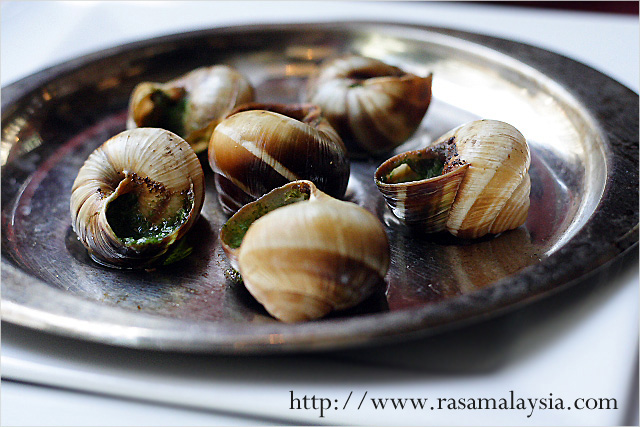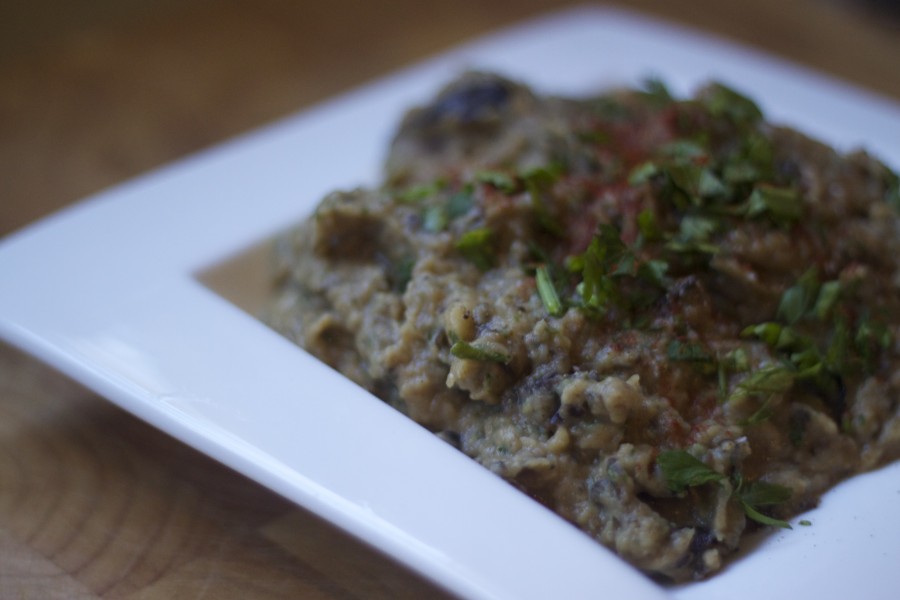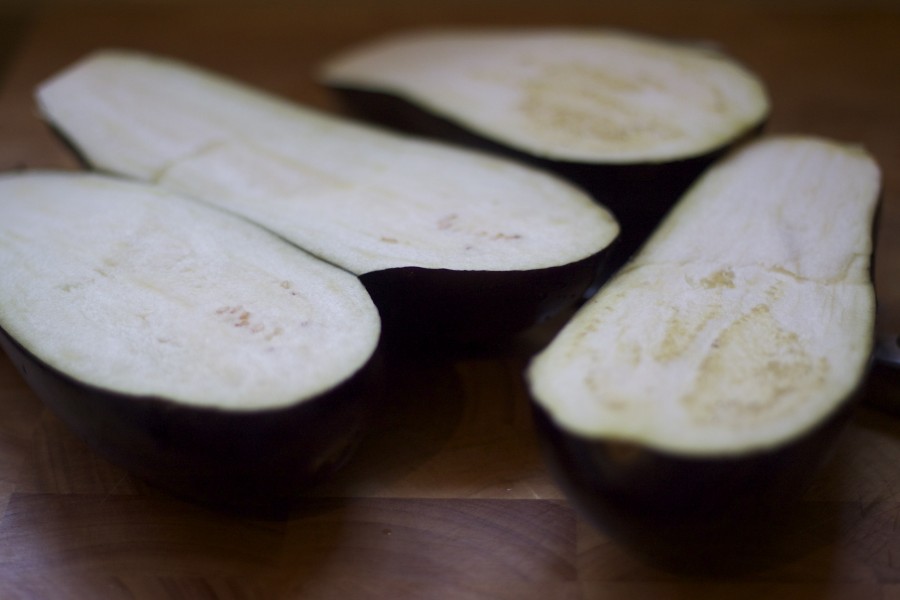loading...
This past week, I had the fabulous opportunity to present a short talk on French Fusion Foods to members of the Tournée Film Festival at LSU. My talk preceded the screening of Entre Les Murs (The Class), a 2008 French film and winner of numerous awards for its look at France’s multiracial school systems.
Below, I offer a post significantly longer than what I typically give my readers–a reprint of my talk on French Fusion Foods for La Tournée. My recipe for Baba Ganoush Follows!
Monday, November 7th, 2011: French Fusion Foods at La Tournée Film Festival
When Jerod asked me to talk about food for the Tournée Film Festival, I was thrilled for another chance to communicate my passion for food and cooking with anyone who would listen. As a food writer, I compose daily recipes and stories for my food, cooking, and recipe blog Clearly Delicious, shorten my stories to more print-ready bi-monthly columns for our state newspaper The Advocate’s Food Section, and chat with my co-host Russ Turley weekly on our iTunes podcast Homemade is Best.
I’m the kind of person who, when asked what the difference between salted and unsalted butter is, I’ll gladly give you an answer. And come up for air ten minutes later.
But in truth, I was surprised when Jerod asked that I discuss French fusion foods as the movie The Class has nothing to do with food, but much to do with cultural change in a modern French classroom.

Combining the flavors of different cultures have long captured our imaginations as chefs and gastronomists, but seldom do changing food trends infringe upon the barriers of so specific and classic a cuisine as the French one. It wasn’t until the 1960s and 70s that French food was anything much more than French despite the repeated resurgence of nouvelle cuisine trends in the country’s history. French food is typically divided by its regional origins, ingredients, and cookery techniques where each region in France produces its own distinct dishes. If there is anything the French know how to do, it’s certainly to preserve and cherish what makes their culture so special. To think that a provincial French dish might be infused with Asian spices is not, necessarily, blasphemous to a French cook, but it’s certainly not French, not in a classical sense anyway.
But the isolated nature of French cooking wouldn’t always be so. As Julia Child explained with the publication of her book Mastering the Art of French Cooking, cooks of the 1960s “were interested in more adventurous foods, and serving those meals at home was becoming a matter of pride.” Long gone were the unsophisticated adventures of TV dinners where the everyday American housewife was less likely to be found warming preservative-laden meals and more likely to be found de-boning a duck in her own kitchen. I find it no surprise that Mastering the Art of French Cooking was published in 1961 and that the company Swanson & Sons stopped using the term “TV Dinners” immediately after in 1962.

Perhaps this is why French Fusion foods first occurred in America. As Adam Gopnik of The New Yorker has observed, the Enlightenment of new fusions in French cooking certainly took place in France, but the Revolution occurred elsewhere. Along with Julia Child’s introduction of French cooking into the 60s American kitchen, a similar wave overcame our national appetites with the famous Imperial Dynasty restaurant in Hanford, California, and later Wolfgang Puck’s menus at Chinois’s in Santa Monica’s and Postio’s in San Francisco’s during the 1980s.
The concept of fusion foods is simple. The concept of French Fusion Foods, however, is not so simple. Allow me to differentiate.
A fusion food dish attempts to accomplish exactly what its name sets forth—to blend together culturally different ingredients in order to form a new whole. The final product stands alone as a distinctive dish. Through the combination of various culinary traditions, fusion foods are never more one tradition than the other. They combine surprisingly opposite ingredients from surprisingly different countries to conceive a harmonious whole that might have the under-current of one country’s flavors (most notably, Asian), but the body of the dish may be more European in nature.
Although “fusion foods” are typically a general umbrella term, the cooking style has some very specific manifestations that vary based on the location of the kitchen in which they are prepared. In America, we best know fusion foods as pretty much everything we eat. A concept like “Taco Pizza” combines Mexican ingredients on an Italian flat-bread, Avocado Egg Rolls dipped in Honey Cilantro Sauce blend quintessential ingredients that are both Asian and Mexican in nature, and Tandoori Sandwiches incorporate Indian spiced meat on Italian Focaccia Bread. In all of these cases, the dish you eat tastes…like, well, both. Both Asian and Italian. Both Asian and Mexican. Both Indian and Italian. Through a unique mingling of ingredients and concepts the dish is both: a fusion.

Allow me to put it this way: ever visit a Chinese food restaurant and have someone say, “this is really good, but it’s not real Chinese food. It’s American Chinese food?” Without its glitz and glamour, the Crab Ragoons or Pork Lo Mein, although incredibly delicious, are also modern takes on fusion food. These menu favorites leave out less traditional Asian spices for an American tongue and we hope that what we eat is “Chinese” food, but in actuality, it’s just American food with some Chinese ingredients.
So how does French Fusion Food sit in this vast sea of mergers where cooks become blind to racial barriers and open to the most unique of marriages? Easy, it started with the Far East.
When governor of California, Ronald Reagan ordered his favorite dish Cornish Game Hen and Poached Salmon served with Egg Fu Yung at The Imperial Dynasty restaurant in California’s rural San Joaquin Valley. When sick, he’d order a bowl of Noodle Soup and a side of Escargot. Richard Wing, the restaurant’s head chef in throughout the second half of the twentieth-century, admitted that “It’s more French cooking than Chinese” and included Russian, German, Italian, and Swiss flavors to this already global menu. The Imperial Dynasty Restaurant became famous for serving foods that were and weren’t traditionally Asian in nature.

Today, other modern chefs are taking a cue from early fusion innovators such as Wing. Susanna Foo, often referred to as “North America’s Finest Asian Chef,” is not hemmed by national or regional boundaries. Her recipes often combine classic Chinese dishes with French techniques and Mexican ingredients. Her Pan-Seared Sweetbreads with Veal Dumplings are prepared with Ancho Chili and served with Sichuan Pickled Relish and Crispy Shallots as just one of her award winning fusion recipes. In fact, she’s credited with bringing Chinese cooking into the modern age through the use of French influences.
In this way, fusion foods become a hot topic for political and cultural debates—what traditions can be blended? Should one tradition be more privileged than the other? And, in light of French Fusion foods, how far can a fusion dish be developed without forsaking its French traditional roots? In 1996, a group of France’s most important chefs issued a manifesto protesting exotic foods and alien spices into their country’s cooking. Their fear was that regionally available ingredients were no longer privileged with the growth of culinary globalization and at stake was their national integrity.
These chefs suffered from many local-vore anxieties, but they represent a larger population of multicultural issues that tend to accompany French Fusion Foods. Often praised for the way it blends diverse cultures, Fusion Foods provide an opportunity to mainstream lesser-known cooking traditions and give opportunities to minority chefs like Foo. In the world of Fusion Cooking, French foods often dominate being the most likely to be improved upon and revised. It is at this nexus of tradition and revision that Fusion Foods are so often criticized for their lack of rules, the ways ingredients may be combined, and how such fusions break down French cooking traditions as if to disregard hundreds of years of cooking culture.
There is no easy answer here and I am want to play my cards as—I’ll eat it, so long as it tastes good. If this screening of The Class gives us any indication, multiculturalism is a huge issue and certainly demands some serious attention.
In moments like these, I am reminded of a shirt I own of Julia Child wielding a whisk. The caption reads, “What would Julia do?” For Julia, the answer was simple—try anything once. In the introduction to the anniversary edition of Mastering the Art of French Cooking, Child writes, “I do think the way to a full and healthy life is to adopt the sensible system of ‘small helpings, no seconds, no snacking, and a little bit of everything.’ What a happy task you have set for yourself! The pleasures of the table are infinite. Toujours bon appétit!”

Baba Ganoush & Fusion Foods at La Tournée Film Festival (Monday, November 7th)
* 1/2 up lemon juice (juice from two lemons)
* 3 garlic cloves, pressed or minced
* 1/2 cup yogurt, Greek-style
* Salt and pepper, to taste
* 1 tablespoon sugar
* 2 tablespoons olive oil
* 2 tablespoons parsley, more to garnish
* smoked paprika, to garnish
* 1 teaspoon liquid smoke
1.) Wash and halve eggplant and remove stems.
2.) Roast eggplant in oven on foil-lined sheet at 425F (about 20-30 minutes, or until tender to the touch).
3.) Add eggplant to food processor with tahini, olive oil, parsley, sugar, garlic, lemon juice, and Greek yogurt. Season to taste with salt and pepper. Plate mixture and and garnish with paprika, salt, pepper, and parsley.
Serve with pita bread, cucumbers, tomatoes, and other fresh vegetables.
Enjoy! Makes 4-6 servings.



No Comments